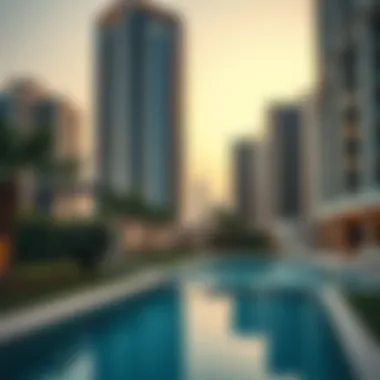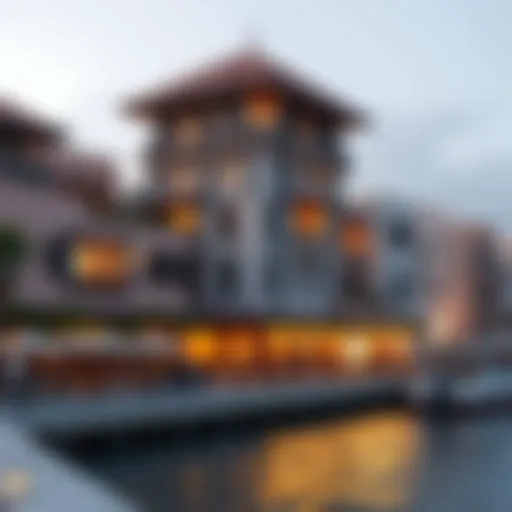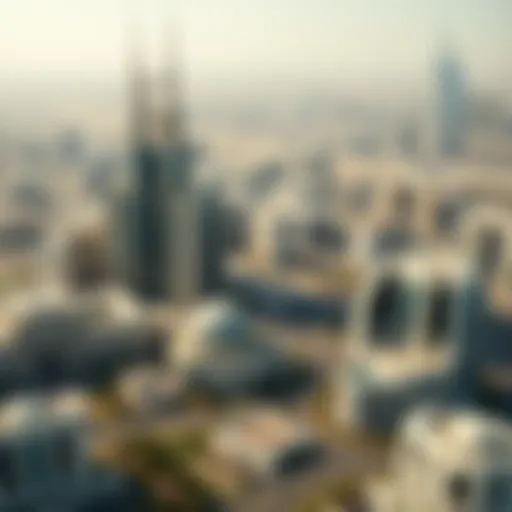Explore Executive Residences in Dubai's Luxury Market


Intro
Navigating the world of real estate in a bustling metropolis like Dubai can feel like diving into a vibrant ocean of opportunity. Among the varied housing options, executive residences stand out, representing the pinnacle of high-end living. But what exactly sets them apart? As Dubai continues to grow and evolve, these residences are more than just luxurious abodes; they embody lifestyle, investment potential, and the ever-changing dynamics of a global city.
In a landscape where skyscrapers touch the clouds and the deserts meet the sea, the essence of luxury living is intricately woven with architectural brilliance, superior amenities, and prime locations. This overview seeks to unravel the allure surrounding executive residences, highlighting their significance within Dubai's real estate market and the advantages they present to prospective buyers and investors.
Expect to delve into current market insights, explore key architectural styles, and uncover what makes certain locations prime for investment. Whether you are an investor scouting for the latest trends or a homeowner in search of your next dream residence, this comprehensive guide aims to educate and inform.
Let’s embark on this journey, dissecting the facets that make executive residences in Dubai essential for those looking to indulge in a luxurious lifestyle.
Understanding Executive Residences
The appeal of executive residences in Dubai extends far beyond mere bricks and mortar; they represent a blend of luxury, functionality, and strategic investment. As the landscape of real estate continues to evolve, these residences have carved their niche, catering to affluent individuals seeking an elevated lifestyle. Understanding what defines an executive residence is crucial for potential buyers and investors aiming to penetrate this vibrant market.
Definition and Characteristics
Executive residences are typically upscale living spaces designed with both style and comfort in mind. They often boast spacious layouts, state-of-the-art amenities, and a myriad of features that elevate everyday living to an exceptional experience. These homes are strategically located in prime areas, ensuring residents have easy access to business districts, entertainment hubs, and luxury shopping centers.
Characteristics of executive residences include:
- High-quality finishes: From polished marble floors to gourmet kitchens equipped with the latest appliances, every detail is meticulously crafted.
- Smart home technology: Many residences integrate advanced home automation systems, allowing residents to control lighting, security, and climate with the touch of a button.
- Community amenities: Residents often have access to exclusive facilities such as swimming pools, gyms, and concierge services, fostering a sense of community while offering ultimate convenience.
"In the world of luxury real estate, executive residences stand out for their commitment to providing not just a home, but a lifestyle."
Differences from Other Residential Types
While the term "residential" can encompass various living styles, executive residences stand apart in several key ways.
- Target Audience: Executive residences are mainly aimed at high-net-worth individuals, including business executives, expatriates, and affluent families. This is contrary to standard residential buildings that serve a broader range of residents.
- Location and Accessibility: Unlike typical apartments or villas that may be situated in suburban or less bustling areas, executive residences are often found in prime locations, close to key business and cultural districts. This proximity tends to enhance their value and attractiveness.
- Investment Potential: The value of executive residences tends to appreciate more rapidly compared to other residential types due to their luxury status and demand. Investors are often drawn to their potential for high rental yields and long-term equity growth.
- Design and Architecture: Whereas general residential spaces may have standard designs, executive residences pride themselves on architectural diversity and cutting-edge designs that cater to modern aesthetics and functionality.
As such, understanding these differences can help both investors and homebuyers make informed decisions as they navigate Dubai's multifaceted real estate market, ensuring they choose a dwelling that aligns with their lifestyle and investment goals.
Architectural Diversity
Dubai's skyline is a veritable tableau of architectural marvels, and the notion of executive residences plays a pivotal role in shaping that skyline. The architectural diversity found in these residences is a testament to the city’s unyielding pursuit of luxury, innovation, and functionality. Each design brings forth unique characteristics, appealing to diverse tastes and lifestyles. This diversity not only serves aesthetic purposes but it also fosters community engagement and supports sustainable living, honing in on the ever-evolving demands of the residents.
Modern Designs
Modern designs in executive residences symbolize the era of minimalism married with cutting-edge technology. These properties typically showcase clean lines, expansive glass facades, and open floor plans that blur the barriers between indoor and outdoor living. Take, for example, the stunning Al Barari community that features homes integrated seamlessly with lush greenery and water features. This modern approach to design prioritizes sustainability, with solar panels and energy-efficient materials baked right into the construction process.
A hallmark of these dwellings is the incorporation of smart home technology. Voice-controlled systems for lighting, security, and climate control not only add convenience but also appeal to tech-savvy investors. As the adage goes, ‘form follows function,’ and these structures embody this principle by focusing on not just aesthetics but also utility and comfort.
Classic Styles
Contrasting with modern designs, classic architectural styles in executive residences are steeped in tradition and timeless elegance. These homes often feature ornate detailing, such as intricate moldings, grand facades, and lush gardens that harken back to traditional architectural practices. Communities like Emirates Hills are prime examples featuring Mediterranean and Venetian designs that radiate opulence and history.
Classic residences appeal to those who value history in their living spaces. They often come with spacious layouts and are built to accommodate families, reflecting social priorities that resonate with a sense of heritage and legacy. Furthermore, they tend to hold their value over time, attracting buyers who appreciate the durability of style.
Eco-friendly Residences
The push for sustainable living has seen a rise in eco-friendly residences that showcase innovative practices. These buildings integrate natural materials, use renewable energy sources, and come equipped with water-saving features — all aimed at reducing carbon footprints. Communities like Dubai Hills Estate lead the charge in combining luxury with responsibility, where homes are designed with green roofs, rainwater harvesting systems, and energy-efficient appliances.
Investors are increasingly drawn to these eco-friendly options, recognizing that they not only meet the growing environmental consciousness but also attract like-minded residents who prioritize sustainability. As more individuals grapple with climate issues, such homes resonate deeply within the market.
"The future of luxury lies in sustainable living; integrating comfort with responsibility."
In summary, the architectural diversity found in Dubai's executive residences provides an enriching array of options for discerning buyers. Each home, whether through modern, classic, or eco-friendly design, speaks to varied lifestyles while also enhancing the urban landscape, making Dubai a jewel of modern living.
Amenities Offered
Understanding the amenities provided by executive residences in Dubai is crucial for both prospective buyers and investors. These features often dictate the quality of life one can expect while living in such luxurious accommodations. In a city that prides itself on opulence and extravagance, these amenities become not merely attractive add-ons but integral components of daily living. They enhance convenience, ensure security, and foster a sense of community among the residents. By offering an array of choices, executive residences cater to diverse lifestyles and preferences, making them a keen consideration in the competitive Dubai real estate market.
Common Amenities in Executive Residences


When it comes to common amenities, one can expect a lineup of features that satisfy various needs. Typical offerings within executive residences encompass:
- Pool Facilities: Many buildings boast upscale swimming pools, often situated on rooftops, providing both leisure and stunning views over the Dubai skyline.
- Gym and Fitness Centers: Residents frequently find well-equipped fitness centers, allowing for convenient workout sessions, saving time compared to traditional gyms located off-property.
- Landscaped Gardens and Parks: Green spaces not only enhance aesthetic appeal but also provide a refreshing spot for relaxation and social gatherings.
- 24/7 Security Services: These residences prioritize resident safety with vigilant security personnel and advanced surveillance systems.
- Concierge Services: A multitude of executive residences offer concierge services aimed at fulfilling any resident's requests, from booking reservations to arranging transportation.
Each of these amenities plays a role in elevating the living experience, offering comfort and convenience in abundance.
Luxury Features
Luxury isn't just a term here; it's a standard expectation. Executive residences in Dubai often include exquisite finishes and high-end features that set them apart:
- Smart Home Technology: Many residences integrate smart tech that allows residents to control lighting, climate, and security remotely, making everyday life seamless and efficient.
- High-Quality Materials: Use of premium materials, such as marble flooring and wooden accents, demonstrate a commitment to quality and attention to detail.
- Private Balconies and Terraces: These spaces offer personal retreats where residents can unwind away from the hustle and bustle of city life while enjoying panoramic views.
- Gourmet Kitchens: High-end appliances and spacious configurations make every kitchen a chef's dream, perfect for hosting guests or enjoying family meals.
- Spa and Wellness Facilities: Some high-end properties feature in-house spa services, offering an escape from daily routines without having to leave home.
These luxury features not only meet the demands of a high-end lifestyle but also add significant value to the property, appealing to discerning buyers.
Exclusive Services
Beyond standard amenities, the allure of executive residences often lies in their exclusive services. These can transform an ordinary day into an extraordinary experience:
- Personal Drivers or Chauffeur Services: Some residences offer the convenience of chauffeur services, granting residents ease of transport throughout this dynamic city.
- Housekeeping and Maintenance Services: Full-time housekeeping ensures that living spaces remain pristine, allowing residents more time to enjoy their day.
- Event and Party Hosting: Access to exclusive event spaces within the property for social gatherings or business meetings elevates the entertainment experience.
- Access to Private Clubs or Lounges: Being part of a private community creates an elite atmosphere, perfect for networking or unwinding after a long day.
The array of exclusive services means that residents can enjoy a lifestyle that many only dream of—a realm where comfort and convenience amalgamate seamlessly.
In summary, the amenities offered in executive residences are foundational elements that define the luxury living experience in Dubai. They highlight the investment potential of such properties, making them attractive for buyers looking for not just a place to live, but a way to live well.
Investment Potential
The investment potential of executive residences in Dubai is a focal point for both seasoned investors and first-time buyers alike. With Dubai's towering skyline and luxurious offerings, the scene is ripe for opportunities. The demand for high-end properties continues to surge, owing to both local and international interest. It’s not just about owning a piece of real estate; it’s about securing a place in one of the world’s most vibrant economies.
Market Trends in Dubai
In recent years, Dubai's real estate market has shown significant resilience. The Expo 2020 catalyzed a surge in luxury property investments, reaffirming the city’s status as a global hub.
- Affordability Rebalance: Contrary to what many believe, high-end properties are becoming more accessible, with developers offering competitive pricing. Investors are witnessing a greater variety of executive residences, catering to diverse tastes.
- International Investments: An influx of foreign investors has resulted in higher demand for executive spaces. Cities across the globe have observed the shifting trends, with many opting for Dubai as a favorable location for investment.
- Technological Integration: Smart homes are gaining traction, ensuring that modern living aligns with technological advancements. Homes equipped with state-of-the-art security systems and home automation not only retain their value but can appreciate over time.
Return on Investment
When discussing executive residences, return on investment (ROI) emerges as a key consideration. The high-end market often offers substantial ROI, especially in a city like Dubai. Factors influencing this include:
- Rental Yields: Properties in premium locations can offer rental yields that frequently surpass those of other real estate types. It’s common to see ROI ranging from 5-8% for luxury properties in sought-after locations.
- Occupancy Rates: Executive residences often appeal to expatriates and business personnel. This continuous demand keeps occupancy rates high, ensuring consistent revenue streams for investors.
"Investors in Dubai’s high-end real estate are likely to benefit from both short and long-term investments, particularly as the economy rebounds."
Long-term Value Appreciation
The long-term value appreciation of executive residences is another vital element worth noting. In Dubai, properties consistently appreciate due to various factors:
- Infrastructure Development: Major projects surrounding executive residences bolster value significantly. With the promise of upcoming roads, schools, and amenities, property prices tend to soar when developments are announced.
- Cultural and Social Investment: UAE’s commitment to creating a multicultural environment fosters a sense of community, further enhancing property values.
- Future Growth Potential: Emerging trends indicate that high-end living remains quintessential in attracting global talent and affluent investors. Given ongoing urban development plans, properties in prime locations are poised for substantial appreciation in the coming years.
In summary, understanding the investment potential in Dubai's executive residences is crucial for anyone aiming to capitalize on the lucrative real estate market. By paying attention to market trends, focusing on ROI, and considering long-term value appreciation, savvy investors can make informed decisions that capitalize on Dubai's dynamic landscape.
Regulatory Framework
The regulatory framework governing executive residences in Dubai is an intricate web that intertwines laws, regulations, and policies set by the government. Understanding these regulations is crucial for anyone considering a purchase, as they directly impact ownership, investment potential, and the overall living experience.
Ownership Regulations
Ownership regulations in Dubai are distinct yet complex. The regulation broadly categorizes properties into two categories: freehold and leasehold. Freehold properties allow foreigners to own land and structures outright, which is a significant draw for expatriates and investors alike. Certain areas, such as Dubai Marina and Downtown Dubai, are designated for freehold ownership, providing the allure of outright ownership.
On the other hand, leasehold properties typically permit a lease for a fixed period, often up to 99 years. This can be a double-edged sword; while it allows access to luxurious properties, the lack of full ownership can deter long-term investment.
It's also essential to consider the implications of the Dubai Land Department’s regulations, which dictate property transactions and enforce standards for developers and agents. Prospective buyers should conduct due diligence, ensuring they work with licensed real estate agents familiar with local laws. Knowledge about these regulations supports a seamless acquisition process, allowing buyers to navigate potential pitfalls with confidence.
Tax Implications
One striking feature of investing in Dubai's real estate market is the advantageous tax landscape. Discerning investors will find relief in the absence of property taxes, which is a rarity in global real estate markets. This absence significantly enhances the return on investment and appeals to high-net-worth individuals looking for lucrative opportunities.


However, buyers should remain cautious about other potential costs, such as registration fees imposed by the Dubai Land Department, which is typically around 4% of the property value. Investors should also consider efits from VAT when purchasing furnishings and renovations, as this can influence the overall budget.
Not to be overlooked, another crucial consideration involves the regulations surrounding rental income. While there are no taxes on residential rental income, any non-resident property owners might still need to familiarize themselves with the potential tax obligations based in their home counties.
"Understanding the regulatory framework in Dubai is akin to navigating a labyrinth; knowing the right paths saves time and protects investments."
In summary, grasping ownership regulations and tax implications in Dubai's executive residence market is indispensable. These elements not only shape investment strategies but also influence market perceptions and lifestyle choices. With an ever-evolving regulatory environment, staying informed grants buyers and investors easier access to Dubai's luxury living landscape.
Both seasoned investors and first-time buyers should consult legal experts or real estate professionals to ensure compliance and obtain tailored advice based on their circumstances. For more detailed guidance on ownership and investment in Dubai, you can refer to resources provided by Dubai Land Department or insights from Emirates Real Estate Solutions.
Understanding these fundamental regulatory aspects lays the groundwork for informed, strategic investment decisions in Dubai's robust real estate market.
Location Considerations
In the realm of executive residences, the significance of location cannot be overstated. The placement of these luxurious abodes plays a critical role in defining not only the living experience but also the investment potential for eager buyers and investors looking to plant their roots in Dubai. Strategic positioning enhances accessibility to vital facilities and has a direct impact on property values. Therefore, understanding location dynamics is a fundamental aspect when considering an executive residence in this bustling metropolis.
Prime Locations for Executive Residences
Dubai boasts a myriad of prime locations, each distinct in character and appeal. Here are some noteworthy areas:
- Downtown Dubai: Often identified as the heart of the city, this area includes iconic landmarks such as the Burj Khalifa and Dubai Mall. The vibrant atmosphere and high-end retail opportunities make it particularly attractive to high-net-worth individuals.
- Dubai Marina: Known for its stunning waterfront views and a cosmopolitan vibe, Dubai Marina is a favored locale among expatriates and locals alike. The variety of high-rise apartments and penthouses offers a unique living experience close to leisure and entertainment hubs.
- Palm Jumeirah: A marvel of modern engineering, this man-made island is synonymous with luxury living. Executive residences here often feature private beaches and exquisite views, making it a sought-after destination for affluent buyers.
- Jumeirah Lake Towers: This area combines residential and commercial properties, appealing to the executive lifestyle with its proximity to business districts and the serene lakes that line the towers.
Choosing a location is not merely about prestige but involves rigorous evaluation of various elements, from connectivity to schools, and from hospital facilities to leisure options. Buyers should weigh these factors carefully to ensure that they invest in a property that meets their lifestyle needs.
Impact of Surroundings on Value
Surroundings can make or break the value of a property. The ambiance and accessibility of an executive residence directly influence its market demand and resale potential. Here are some considerations:
- Neighborhood Quality: A well-maintained neighborhood with aesthetic appeal tends to draw higher demand. Buyers often seek communities with lush greenery and low noise levels, enhancing their living experience.
- Proximity to Amenities: Properties situated near essential services, including schools, healthcare facilities, and shopping centers, are valued more highly. Investors understand that convenience is paramount when families consider relocating, thus creating greater market agility.
- Future Developments: Planning and ongoing infrastructure projects can have a profound effect on property values. A recently announced metro line, for instance, can see a rise in demand for nearby residences as transportation becomes more accessible.
In a city like Dubai, where rapid growth intersects with luxury, the importance of surroundings can't be overlooked—it's more than just real estate, it’s about lifestyle.
In sum, as prospective buyers and investors explore executive residences in Dubai, they must pay attention not only to the properties themselves but also to the environments that surround them. The interplay between location and surroundings shapes not just the aesthetic appeal of these homes but their future financial viability as well.
Target Demographics
Understanding who invests in executive residences in Dubai is vital. The demographic distinctions allow sellers and developers to tailor their marketing strategies effectively. Not everyone looking at high-end properties has the same needs or perspectives. The savvy buyer, typically someone with substantial financial resources, views executive residences not just as homes but also as an investment — a way to establish security or even a portfolio addition.
Who Invests in Executive Residences?
When it comes to investments in executive residences, there are diverse types of buyers.
- High Net-Worth Individuals (HNWIs): These investors often wish to secure high-value assets in growing markets. They are often keen on locations that offer a combination of prestige and practicality, making Dubai a prime choice.
- Business Executives: Many executives find themselves relocating to Dubai either for work or as part of a global expansion. They look for residences that provide luxury but also practicality. Proximity to business districts might be a deciding factor.
- Foreign Investors: In recent years, Dubai has attracted international buyers who seek favorable investment environments. The notion of owning property in a city known for its safety and business potential appeals to these investors.
- Families: Families often look at executive residences for the schools, health facilities and recreational activities in the vicinity. They seek neighborhoods that bolster their children's education while offering a luxurious lifestyle.
These categories interact in complex ways. A family may value the same features as a business executive; however, the context of their investment decision might differ significantly.
Family vs. Investor Perspectives
The juxtaposition of family needs against investor motivations highlights a distinct split in priorities when considering executive residences.
- Families are typically drawn to aspects such as spaciousness, safety, and school districts. Their focus is on long-term residency. A home in a reputable area signifies stability, comfort, and accessibility. They might prioritize residences near parks and community centers, while investors may not lend as much weight to these considerations.
- Investors, on the other hand, see executive residences through the lens of financial metrics. They are more inclined to assess potential rental yields, market growth, and resale value. Their decisions are often driven by the lure of profit rather than emotional attachment.
In summation, while both families and investors are interested in prime residential offerings, their motivations tell different stories. Families yearn for homes; investors ponder opportunities. This distinction is key in the marketing and development of executive residences in Dubai, as understanding these varied needs can guide property developers in crafting exactly what each group desires.
"The true value of a residence is shaped not just by the walls around it, but by the lives lived within those walls."
Recognizing these differing perspectives aids in navigating the luxury residential landscape. Dealers, developers, and investors can work to ensure that executive residences in Dubai meet the nuanced preferences of their target markets.
Comparative Analysis
In the realm of Dubai’s luxury real estate, a comparative analysis becomes crucial for discerning buyers and investors looking to make informed decisions. This section dissects the nuances between different types of high-end living options: executive residences, luxury villas, apartments, and houses within executive residences. By understanding these differences, potential residents can better align their choices with their lifestyle and investment goals.
Executive Residences vs. Luxury Villas


Both executive residences and luxury villas embody elegance and sophistication, yet they cater to distinct tastes and preferences. Executive residences typically offer a blend of convenience and community living, often situated in bustling hubs of the city like Dubai Marina and Downtown Dubai. They are ideal for those seeking a lock-and-leave lifestyle, with many amenities at their doorstep, including gyms, pools, and access to dining and shopping.
On the other hand, luxury villas present more privacy and exclusivity. These homes are often located in quieter, more serene neighborhoods like Arabian Ranches or Jumeirah, emphasizing open spaces, landscaped gardens, and personal pools. The allure of a luxury villa largely stems from its spaciousness and custom design, catering to families who value personal space more than a fast-paced urban environment.
Here's a clearer breakdown of the two:
- Executive Residences:
- Luxury Villas:
- Typically multi-family units.
- Located in urban areas.
- High-end facilities like gyms and concierge services.
- Great for those who travel frequently or work in the city.
- Standalone units emphasizing privacy.
- Generally found in tranquil communities.
- Customizable layouts and extensive outdoor spaces.
- Ideal for families desiring a close-knit environment.
Ultimately, the choice between the two often depends on lifestyle preferences, space requirements, and personal goals for living.
Apartments vs. Houses in Executive Residences
When comparing apartments to houses within executive residences, the conversation centers around space versus convenience. Apartments in executive residences, such as those in Marina Gate or The Address, appeal to those who appreciate modern layouts and can benefit from shared amenities. These apartments often come equipped with luxury finishes and smart home technologies, offering ease of living that aligns with the fast-paced lifestyle of many expatriates and locals.
On the contrary, houses within executive residences such as those found in gated communities often provide both privacy and spacious living areas. These homes allow for greater personalization, typically offering private gardens and more extensive entertaining spaces. Families who value having a private retreat will find houses more appealing, despite potentially higher maintenance responsibilities.
Key distinctions include:
- Apartments:
- Houses:
- Generally less maintenance; suitable for busy individuals or couples.
- Usually found in vibrant urban settings with easy access to amenities.
- Smaller living spaces suited for quick, efficient lifestyles.
- More room to grow; ideal for families.
- Possibility of outdoor spaces for activities or gardening.
- Greater opportunities for customization and renovations.
Understanding these dynamics not only aids buyers in selecting the right type of dwelling for their needs but also augments their investment strategy in the highly dynamic Dubai real estate market. By making informed choices, buyers can ensure that they are aligning their investments with their aspirations and lifestyle preferences.
"In a city known for its extravagant choices, the nuances between residential types may define your experience and satisfaction in Dubai's real estate landscape."
For a deeper dive into the intricacies of Dubai's property market, feel free to explore resources such as Wikipedia or Britannica.
These comparative insights serve as a stepping stone for potential buyers, providing clarity in a market rich with options and possibilities.
Future Outlook
As we take a gander at the horizon, the future of executive residences in Dubai seems laden with potential and promise. This segment aims to unveil the critical shifts expected in the market, driven by emerging trends and preferences among affluent buyers. The significance of discussing the future is twofold—it not only prepares prospective investors and homeowners for what’s coming, but it also highlights the adaptability of Dubai's luxury real estate sector in the face of evolving demands.
Predicted Market Changes
The winds of change are blowing through Dubai’s residential market, and a few key predictions stand out:
- Increased Demand for Sustainable Living: Eco-conscious living is no longer a trend; it’s transforming into a necessity. Many buyers are seeking residences that incorporate green technologies and sustainable materials. This not only enhances the lifestyle but also aligns with global environmental goals.
- Rise of Integrated Communities: Buyers are gravitating towards neighborhoods that offer a blend of residential, commercial, and recreational spaces. This shift reflects a desire for convenience and lifestyle integration. Expect to see developments that creatively blend work and play, catering to needs all under one roof.
- Technological Integration in Homes: Homebuyers are increasingly demanding smart home features—think automated systems that control lighting, temperature, and security at the tap of a screen. Vendors that meet these demands are likely to find favor in a competitive market.
- Fluctuating Prices: As the high-end market grows, price adjustments could be anticipated based on factors like location, amenities, and historical value. Investors should keep a close eye on these fluctuations to capitalize at the right moment.
By understanding these predicted changes, buyers and investors alike can strategically position themselves within the market.
Technological Advances in Residence Design
The impact of technology on residence design is profound, particularly for executive homes. As we look into the future, several areas stand out:
- Smart Home Features: Think about integrating systems controlled through smartphones; from turning on the coffee maker to ensuring the security system is armed. Technologies like voice assistants and advanced AI are becoming commonplace, appealing to a tech-savvy buyer demographic.
- Home Automation for Comfort: The rise of automated systems that adjust settings based on personal preferences creates more comfortable living environments. Lighting that adapts to the time of day or HVAC systems that learn your cooling preferences are excellent examples of how comfort can expand with innovative technology.
- Sustainable Technology: Innovations such as solar panels, energy-efficient appliances, and smart meters help reduce homeowners' carbon footprint while also cutting down utility bills. This tech-forward approach is becoming appealing for buyers who are environmentally minded.
- Virtual Reality in Design: The use of VR allows prospective buyers to walk through properties nearly in real-time and visualize their designs before construction is complete, merging convenience with imaginative possibilities.
Embracing these technological advances can give executive residences in Dubai a cutting edge, offering potential buyers modern comforts that match their aspirations.
"In the dynamic world of real estate, the ability to foresee market trends and adapt to technological advancements is key to thriving in Dubai’s luxury sector."
For those sure about investing, following trends is vital. Knowledge is power, and being well-informed might just set you ahead of the curve.
Epilogue
The conclusion of this exploration into executive residences in Dubai serves as a pivotal reflection on the entire discussion. Navigating through the myriad characteristics, amenities, and investment opportunities related to these residential offerings illuminates the vital role they play in the luxury real estate market.
Summarizing Key Insights
As we piece together the insights shared throughout this article, it's clear that executive residences are not just about lavish living spaces; they embody an entire lifestyle. Here are some key takeaways that clarify their significance:
- Diverse Architectural Styles: The array of designs found in Dubai’s executive residences showcases a blend of modernity and tradition, attracting diverse tastes. From sleek, glassy towers to ornate classical structures, there's something to cater to every preference.
- Top-tier Amenities: These residences often come equipped with high-end amenities that elevate daily living. For instance, private pools, gyms, and spa facilities are common. Additionally, smart home technologies are increasingly integrated, enhancing convenience and energy efficiency.
- Strategic Location: The value of a property is closely tied to its location. Areas like Downtown Dubai and Palm Jumeirah offer unrivaled access to shopping, dining, and cultural experiences, driving up demand for executive residences.
- Investment Opportunities: With robust market trends suggesting not just stability but appreciation in property values, investors are eyeing these residences as prime sources for long-term returns. The attractiveness of these properties continues to swirl around their ROI prospects.
- Regulatory Frameworks: Understanding the nuances of ownership regulations and tax implications is crucial. There’s a substantial framework that guides foreign and local investments, which makes seeking legal guidance a wise step when navigating purchases.
- Diverse Buyer Demographics: The landscape is populated by a mix of buyers, from affluent families looking for long-term residences to investors scouting for profitable opportunities. This dynamic creates a vibrant market situation that benefits all parties involved.
In sum, executive residences in Dubai encapsulate a unique lifestyle marked by luxury, resilience in investment prospects, and architectural ingenuity. The insights gleaned from this article indicate not just a place to live, but a smart choice in the ongoing evolution of Dubai’s real estate market. As potential buyers and investors forge forward, it is clear that these residences are not simply homes—they are significant investments in a burgeoning landscape.











